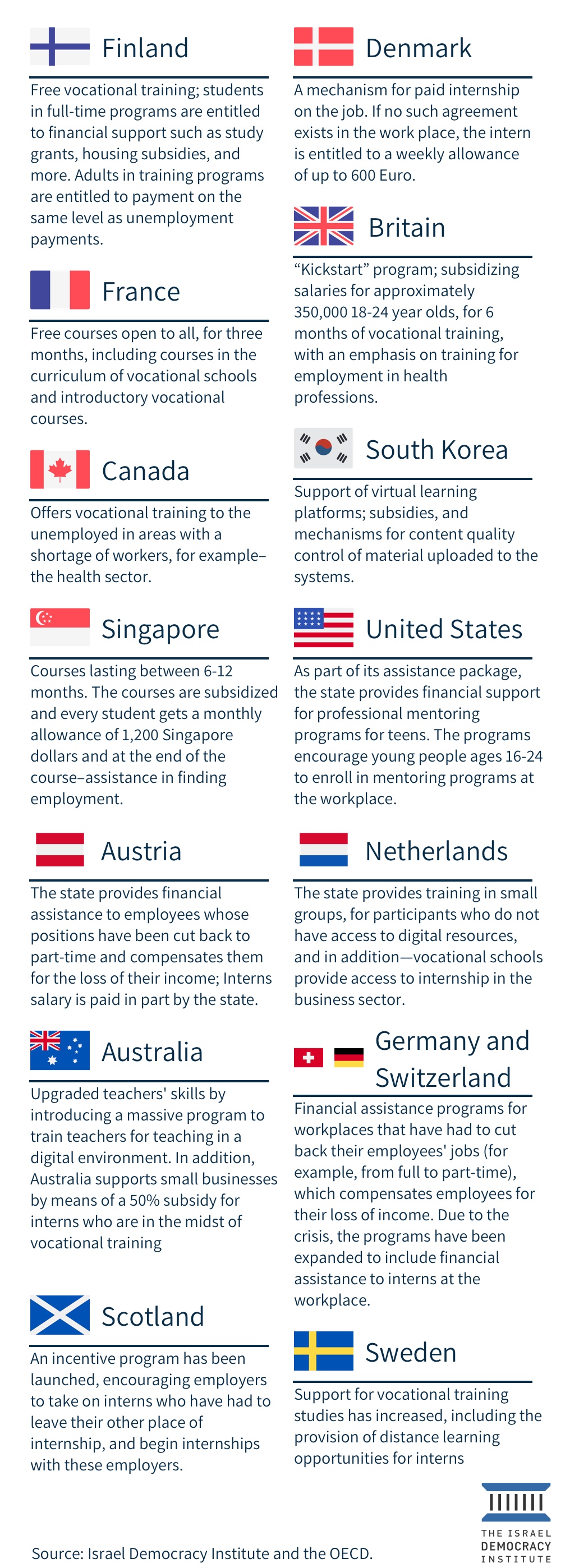How to Generate Demand for Workers
A growing number of countries around the world have realized that vocational training and subsidies for the training period can increase the demand for workers. Israel's government should follow this lead, while at the same time accelerating the pace of development of infrastructure projects, to increase the demand for skilled workers.

Flash 90
All of us now understand that this is not "just" a crisis limited to a few specific industries that have been shut down. Rather, a snowball effect has dealt a blow to a wide range of industries, businesses, and to both the self-employed and salaried workers. In fact, there are almost no economic branches or population groups that have not been hit. Given that in Israel today, one in four individuals who were employed until recently, is not working (unemployed, furloughed, or the self-employed who had to shut down their businesses), and the fact that the situation is similar worldwide ,it is clear that the corona crisis is fast becoming a global crisis of demand for workers.
Furthermore, the pandemic has turned out to be with us for longer than we initially thought, and is expected to last at least a year. Both the public and businesses are gearing up in response to the uncertainty of the situation, and cutting back on expenses. Thus, we are seeing a combination of declining demand in Israel and around the world, alongside an initiated lockdown (complete or almost complete) of many industries (tourism, aviation, recreation, culture, etc.)
Many businesses that have not been directly impacted by the crisis, have had to deal with a significant drop in orders, leading—in turn—to a significant drop in demand for workers. In the current situation, we should take caution not to allocate additional budgets to employers for hiring employees who are in reality not needed at this time. All this does is to encourage the temporary hiring of employees, and is likely to deal a blow to the survival capacity of those businesses, who might be tempted, to bring their employees back to work only in order to be eligible for government subsidies.
At this stage, the government must quickly move forward to encourage local demand, to spur economic activity and create new jobs, through a combination of four main channels of action:
Physical Infrastructure — roads, renewable energy and green building
Human Capital — vocational training, vocational retraining and online study systems
Vocational Training — providing vouchers for vocational training for the unemployed, those on unpaid leave and those whose positions have been cut back to part-time
Partial Wage Subsidies — Preventing or limiting of a second wave of unemployment and layoffs through partial wage subsidies for workers whose employers reduce the scope of their positions (which is known as the German model, and is now practiced all over Europe)
Following are several proposed tracks for action:
A model combining 2-3 days of training provided by employers either through an external course or at the workplace, for which the government will pay the employees’ wages; and in which—for the rest of the week—the employee will work at the workplace and be paid directly by the employer. The employer will choose the training courses; the training will be financed by the State and —in addition—the State will finance between 50-80% of the workers’ wages for the days of training. The OECD recommends that training should focus on younger workers who have been hit hard by the crisis, to prevent the creation of a “lost generation” who in the future—become chronically unemployed as a result of the corona crisis.
1) Vocational retraining for both self-employed and salaried workers who until now worked in branches and occupations which have been locked down and which are not expected to return to activity in the coming year, Individuals applying to state-funded retraining courses will be eligible for living benefits. Equivalent to unemployment payments.
2) Vouchers for state-funded training in basic skills (language, digital skills) for all those eligible for unemployment payments (unemployed, or on unpaid vacation) and for the self-employed who are interested in the program, without losing the eligibility for unemployment payments.
What's going on in the world?
In Europe, the importance of vocational training was acknowledged even before the corona crisis. Countries such as Germany, Switzerland, Denmark, Finland, and Austria offer a flexible and dynamic training system, tailored to the needs of employers, thanks to the close connection which exists between training systems and employers (which does not exist in Israel), mechanisms for internship on the job, and an emphasis on lifelong learning and preparation for the demands of the future labor market. Now, in the very midst of the crisis, these countries have the capacity for a flexible and rapid response to the situation, thanks to their ability to offer training and retraining to the “corona unemployed”.

It is hard to ignore the fact that what all these programs share in common is their collaboration with employers to conduct at least part of the training at the workplace.
We estimate the cost of implementing the proposed vocational training model as about NIS 1 billion for every 100,000 people undergoing vocational training. This estimate includes the costs of running the training programs (a significant portion of the training will be conducted online) and for providing the financial grants (bonuses) to employees who sign up and those who complete the courses.
The estimate does not include the cost of paying the living allowance to trainees, since these costs replace unemployment benefits and so—additional expenses are not incurred. On the contrary, the plan may even reduce the cost of unemployment benefits, if employers do not opt to send their workers to unpaid vacation, and instead—take advantage of this period of time for vocational training for these workers.
